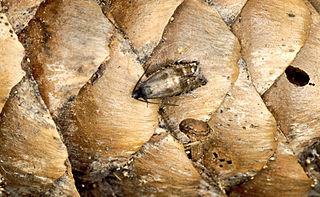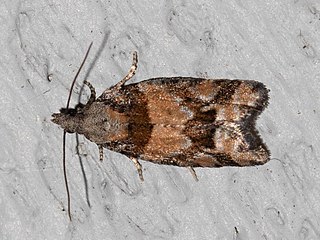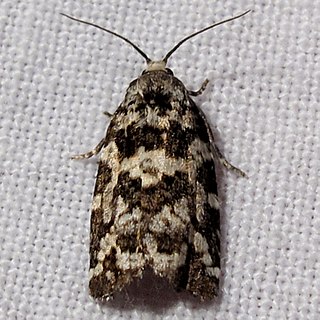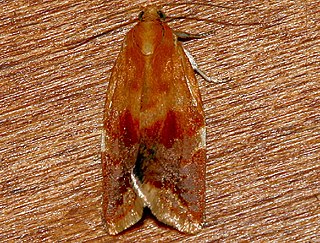
A spruce is a tree of the genus Picea, a genus of about 40 species of coniferous evergreen trees in the family Pinaceae, found in the northern temperate and boreal (taiga) regions of the Earth. Picea is the sole genus in the subfamily Piceoideae. Spruces are large trees, from about 20 to 60 m tall when mature, and have whorled branches and conical form.

Picea abies, the Norway spruce or European spruce, is a species of spruce native to Northern, Central and Eastern Europe.

Cydia strobilella, the spruce seed moth, is a moth of the family Tortricidae. It is found in Europe.

Cydia pactolana, the spruce bark tortrix, is a moth of the family Tortricidae. It is found in central, northern and eastern Europe as well as Siberia. In Japan, the subspecies Cydia pactolana yasudai is present.

Argyrotaenia is a genus of moths in the tribe Archipini within the family Tortricidae.

Epinotia nanana, the European spruce needleminer, is a moth of the family Tortricidae. It is found from northern and central Europe to Russia and Mongolia.

Zeiraphera ratzeburgiana, the spruce bud moth or Ratzeburg tortricid, is a moth of the family Tortricidae. It is found from northern and central Europe to eastern Russia and China. Zeiraphera ratzeburgiana is a taxonomically similar species to Zeiraphera canadensis and can only be distinguished by an anal comb found in Z. canadensis.

Cydia illutana is a small moth of the family Tortricidae. It is found from western and central Europe, north to Scandinavia and east to Russia (Siberia).

Argyrotaenia dorsalana is a moth of the family Tortricidae. It is found in North America from British Columbia and Washington, south to California and Utah.

Epinotia radicana, the red-striped needleworm moth, is a species of moth of the family Tortricidae. It is found in western Canada, including British Columbia and Alberta.

Henricus fuscodorsana, the cone cochylid moth, is a species of moth of the family Tortricidae. It is found in western North America, where it has been recorded from Arizona, British Columbia, California, Colorado, Idaho, Oregon and Washington.

Archips strianus, the striated tortrix moth or striated leafroller, is a species of moth of the family Tortricidae. It is found in North America, where it has been recorded from Alberta, British Columbia, Maine, Michigan, Minnesota, Montana, New Brunswick, Newfoundland, Ontario and Quebec.

Archips packardianus, the spring spruce needle moth or spruce needleworm, is a species of moth of the family Tortricidae. Spruce needle worms are commonly found in small numbers on spruce and trees of other coniferous genera throughout most of Canada and the northeastern US. Archips packardiana overwinters as a tiny larva in a mined needle. Needle mining is resumed in the spring, the larvae later moving to feed on new foliage, where they spin considerable webbing. Full-grown larvae have a pale green head, sometimes patterned with brown, and a pale body and pale thoracic legs, and are about 20 mm long. The larva pupates, usually in the webbed needles, and the adult emerges in summer to early fall. The closely related Archips strianus is much less common, but probably has a habitat similar to that of A. packardiana. The larvae have dark thoracic legs and small dark areas around the base of the thoracic hairs. The habitat consists of coniferous and mixed woods.
Argyrotaenia kimballi, Kimball's leafroller moth, is a species of moth of the family Tortricidae. It is found in the United States, where it has been recorded from Alabama, Florida, Louisiana, Maryland, Mississippi, North Carolina, South Carolina, Tennessee and Texas.

Argyrotaenia tabulana, the jack pine tube moth or lodgepole needletier moth, is a species of moth of the family Tortricidae. It is found in North America, where it has been recorded from Alabama, Arkansas, British Columbia, Florida, Georgia, Indiana, Louisiana, Maine, Maryland, Massachusetts, Mississippi, New Jersey, New York, North Carolina, Ohio, Oklahoma, Pennsylvania, South Carolina and West Virginia.
Argyrotaenia repertana is a species of moth of the family Tortricidae. It is found in North America, where it has been recorded from Maine, Manitoba, Massachusetts, New Brunswick, Nova Scotia, Quebec, Saskatchewan and Washington.
Argyrotaenia lautana is a species of moth of the family Tortricidae. It is found in the United States, where it has been recorded from Arizona and California. It is also found in Mexico.

Argyrotaenia provana is a species of moth of the family Tortricidae. It is found in North America, where it has been recorded from Arizona, British Columbia, California, Colorado, New Mexico, Utah, Washington and Wyoming.

Clepsis persicana, the white triangle tortrix or the green needleworm, is a species of moth of the family Tortricidae. It is found in North America, where it has been recorded from Alaska and British Columbia to Newfoundland and south to Virginia and west to California. The habitat consists of coniferous and mixed coniferous forests.
Epinotia subsequana, also known as the dark spruce moth, is a species of moth belonging to the family Tortricidae. It was described by the English entomologist, Adrian Hardy Haworth in 1811 and is native to Europe.















